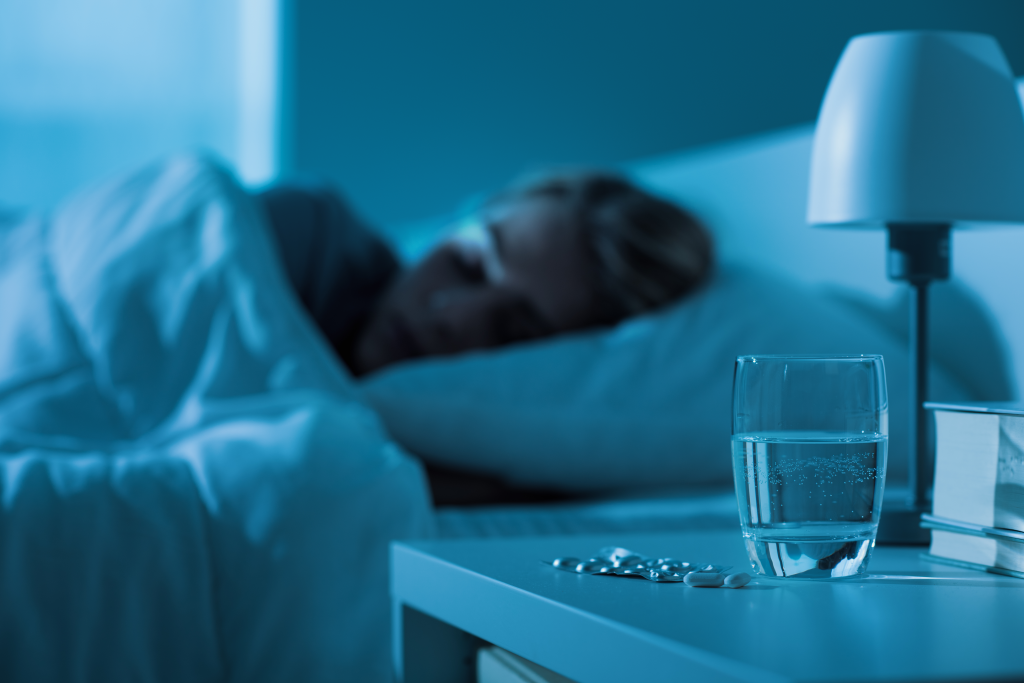At a glance
Vitamin D is an essential nutrient that supports calcium balance, immune health, and hormone regulation. Taking vitamin D3 before bed may help support melatonin production and promote deeper, more restful sleep.
Can you take vitamin D at night? Absolutely!
Vitamin D, also known as the sunshine vitamin, plays an essential role in maintaining bone health, promotes a strong immune system, and has surprising impacts on sleep regulation.
Find out why taking a vitamin D supplement at night may help enhance your sleep quality.
Can vitamin D3 help support sleep?
Vitamin D3 is a fat-soluble vitamin produced in the skin in response to sun exposure. It’s also found in certain foods, including fatty fish, egg yolks, and organ meats.
However, most food sources contain only small amounts of this essential nutrient, and dietary intake alone is unlikely to support healthy vitamin D levels.
Vitamin D supplementation is a convenient way to promote balanced levels, and research published in Current Pharmaceutical Design suggests that optimal vitamin D blood concentrations are linked to longer sleep duration and better overall sleep quality.1
Although the link between vitamin D and sleep hasn’t been fully understood, vitamin D appears to promote the production of melatonin, a pineal hormone that triggers sleepiness and prepares your body for sleep.
This may explain why individuals with vitamin D deficiency frequently report restless sleep or difficulty falling asleep.
How much vitamin D you need depends on many factors, including your vitamin D blood levels, sunlight exposure, geographic location, medication use, skin tone, and body weight.
While most healthcare providers recommend a daily intake of 600 IU of vitamin D, this amount may be insufficient for individuals who are deficient or receive little to no sun exposure.
Therefore, it’s important to consult a healthcare provider to assess your vitamin D blood levels and determine an appropriate dosage based on your individual needs, lifestyle, and overall health status.

Can you take vitamin D3 at night?
Evidence published in Nutrients found that taking vitamin D at night may improve both sleep quality and duration, and suggests that evening supplementation appears to offer the greatest benefit for promoting restful sleep.2
It’s important to note that vitamin D is a fat-soluble nutrient and requires dietary fats and sufficient bile flow for maximum intestinal absorption.
To boost vitamin D absorption, it’s best to consume it in combination with healthy fats such as olive oil, grass-fed butter, medium-chain-triglycerides (MCT) oil, or avocado.
When not to take vitamin D before bed
While vitamin D may help promote healthy sleep in some, others appear sensitive to its effects on the sleep-wake cycle and can experience sleep issues if taking vitamin D later in the day.
“Although it’s not fully understood why, postmenopausal women and older adults may be at an increased risk of poor sleep when taking vitamin D at night,” explains Dr. Berg. “Listen to your body and adjust the timing of supplementation if sleep disturbances worsen.”
Key takeaways
- Taking vitamin D3 at night may improve sleep quality and duration for some individuals.
- Vitamin D supports melatonin synthesis, helping regulate the body’s natural sleep-wake rhythm.
- For optimal absorption, pair vitamin D with healthy fats such as olive oil, butter, or avocado.
- Some people, particularly older adults, may experience sleep disturbances when taking vitamin D at night and should adjust the timing based on their individual response.
FAQ
1. Can I take vitamin D supplements before bed?
Yes, you can take vitamin D before bed, and some people report improved sleep quality when taking it later in the day.
2. Can vitamin D help with sleep?
Vitamin D has been found to modulate the body’s sleep-wake cycle, which may help promote healthy sleep, enhance sleep quality and duration, and reduce the time it takes to fall asleep.
3. What does vitamin D do for sleep?
Vitamin D supports healthy sleep cycle regulation and has been found to stimulate the production of melatonin, a sleep-promoting hormone that is essential for healthy sleep patterns.
4. Can I take vitamin D without food?
While you can take vitamin D without food, it’s not recommended. Vitamin D is fat-soluble and is best absorbed when taken with a meal that contains healthy fats.
5. Can I take vitamin D every night?
Yes, taking vitamin D daily is generally considered safe and effective in supporting healthy vitamin D levels.
6. Does taking vitamin D at night affect your sleep?
Taking vitamin D at night can promote healthy sleep cycles and may help improve sleep quality and sleep duration. However, some individuals appear sensitive to taking vitamin D later in the day and may experience trouble sleeping.
7. Does vitamin D make you sleepy?
Vitamin D itself is non-drowsy and doesn’t make you sleepy. However, vitamin D supports the production of melatonin, a hormone that promotes sleepiness and prepares your body for sleep.








